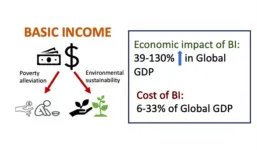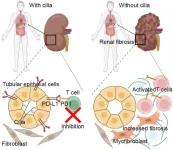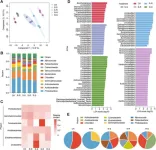(Press-News.org) FOR IMMEDIATE RELEASE
By studying mutations in yeast and human cells, Johns Hopkins Medicine scientists say they have found that biochemical bonds between fats and proteins in the mitochondrion, the cell’s powerhouse, play a crucial role in how our cells produce energy.
The study results, published June 5 in The EMBO Journal, shed new light, researchers say, on the way the altered mitochondrial membranes found in people with metabolic diseases such as Barth syndrome, a rare genetic disorder that weakens the heart, fail to enable cellular power production.
Metabolism is a set of biochemical reactions central to making energy to fuel life and to getting rid of substances a body no longer needs. Metabolic diseases include forms of high cholesterol that run in families. Approximately one in three adults have some form of a metabolic syndrome, according to the National Heart, Lung, and Blood Institute.
Building on previous research, the Johns Hopkins scientists sought to better understand the interaction of two components in the mitochondrial membrane: cardiolipin, a fatty compound, or lipid, and proteins that transport the building blocks of adenosine triphosphate, or ATP, an energy molecule made by the mitochondria that fuels cell metabolism.
“Down the line, a better understanding of protein-lipid interactions could help researchers find new therapeutic targets for a wide range of metabolic diseases, including Barth syndrome,” says senior author Steven Claypool, Ph.D., professor of physiology at the Johns Hopkins University School of Medicine.
He says previous studies suggested it’s likely that protein-lipid interactions in mitochondrial membranes play an important role in regulating mitochondria’s powerhouse activities.
The researchers conducted their experiments in samples of yeast with mutations, or alterations, in a mitochondrial membrane protein called AAC and samples of human cells that modeled a person with a mutation of the protein ANT1 who was diagnosed with metabolic disease, symptoms of which include weakness in the heart and skeletal muscles, exercise intolerance and hyperlactatemia, or elevated lactate levels in the blood.
The protein in yeast, AAC, is the equivalent of ANT in humans, Claypool says.
Looking at three areas where cardiolipin binds to the AAC proteins in yeast, Claypool and his colleagues found that when they introduced mutations into AAC2 to disrupt these interactions, cardiolipin could no longer bond to the protein, which weakened its structure and lowered its function.
Similarly, in the cell model of the person with mutations in ANT1, the protein’s structure was weakened, limiting its ability to transport ATP across the mitochondrial membrane.
“These findings indicate that when the interaction between cardiolipin and proteins break down, the entire process that makes mitochondria our powerhouse is disrupted,” says first author Nanami Senoo, Ph.D., a postdoctoral fellow in Claypool’s lab.
Claypool says few studies have detailed individual protein-lipid interactions, and many more experiments will be needed to “understand the full complement of mechanisms and roles that these interactions have in the membrane.”
Mitochondrial membranes contain a lot of proteins, many of which associate with lipids.
“This discovery opens up new possibilities for understanding the complexities of how our cells produce energy,” Claypool says. “In the future, we plan to explore how other protein-lipid interactions contribute to energy production.”
Other scientists who contributed to the study are Matthew G. Baile, Oluwaseun B. Ogunbona, James A. Saba, Teona Munteanu, Yllka Valdez, Kevin Whited and Macie S. Sheridan of Johns Hopkins; Dinesh K. Chinthapalli, Bodhisattwa Saha, Abraham O. Oluwole, Dror Chorev and Carol V. Robinson of University of Oxford; Vinaya K. Golla, Nathan N. Alder and Eric R. May of University of Connecticut.
Funding for this study was provided by the National Institutes of Health (R01HL108882, R01HL165729, R35GM119762, T32GM007445 and T32GM136577), the American Heart Association, the Uehara Memorial Foundation, the Barth Syndrome Foundation and the Royal Society Newton International Fellowship.
DOI: 10.1038/s44318-024-00132-2
END
Fat molecule’s inability to bond with shape-shifting protein in cell’s powerhouse linked to an inherited metabolic disease
2024-06-07
ELSE PRESS RELEASES FROM THIS DATE:
Wildfire smoke reached 99% of U.S. lakes in 2019-2021
2024-06-07
Where there’s smoke, there’s not necessarily fire.
Wildfire smoke, sometimes drifting from hundreds of miles away, touched nearly every lake in North America for at least one day per year from 2019 to 2021, according to a study from the University of California, Davis.
Even more significantly, the study, published in the journal Global Change Biology, found that 89% of the lakes in North America experienced smoke for more than 30 days during each of those three years of intense wildfire activity.
“That was surprising, even ...
Basic income can double global GDP while reducing carbon emissions
2024-06-07
Giving a regular cash payment to the entire world population has the potential to increase global gross domestic product (GDP) by 130%, according to a new analysis published June 7 in the journal Cell Reports Sustainability. Researchers suggest that charging carbon emitters with an emission tax could help fund such basic income program while reducing environmental degradation.
“We are proposing that if we can couple basic income with environmental protection, we can save two birds with one stone,” says first author U. Rashid Sumaila of the University of British Columbia in Vancouver.
Sumaila has been working on ending harmful fishery subsidies worldwide, but many people who rely ...
The rate, nature and transmission of mitochondrial DNA mutations in humans
2024-06-07
A new study from deCODE genetics uses pedigrees and sequence data from 64,806 Icelanders to shed light on the rate and nature of mutations in mitochondrial DNA (mtDNA) and the peculiar dynamics of its maternal transmission.
In a paper published today in Cell, scientists from deCODE genetics, a subsidiary of Amgen, present the largest study to date of germline mtDNA mutations in humans and their transmission across 116,663 mother-child pairs. The study documents the astonishing extent of hypermutability at some positions in mtDNA, including the well-known deleterious A>G mutation at position 3243 which causes the MELAS syndrome. The mutation ...
Prevalence of iron deficiency using 3 definitions among women in the US and Canada
2024-06-07
About The Study: Three definitions of iron deficiency were associated with significantly different prevalence of iron deficiency in women, regardless of self-reported age, pregnancy, or race and ethnicity. Using higher serum ferritin thresholds to define iron deficiency could lead to diagnosis and treatment of more women with iron deficiency and greater reduction of related morbidity.
Corresponding Author: To contact the corresponding author, James C. Barton, M.D., email bartonjames336@gmail.com.
To access the embargoed study: ...
Bariatric metabolic surgery vs glucagon-like peptide-1 receptor agonists and mortality
2024-06-07
About The Study: Bariatric metabolic surgery was associated with greater reduced mortality compared with first-generation glucagon-like peptide-1 receptor agonists (GLP-1RAs) among individuals with a diabetes duration of 10 years or less, mediated via greater weight loss in this cohort study. No differences in the risk for mortality were observed between the treatment modalities among individuals with a longer duration of diabetes, nor in the occurrence of nonfatal major adverse cardiovascular events among all patients.
Corresponding Author: To contact the corresponding author, ...
Primary cilia restrict autoinflammation by mediating PD-L1 expression
2024-06-07
Ciliopathies are multisystem disorders characterized by the dysfunction of motile and/or non-motile cilia, which show common clinical manifestations of ciliopathies include retinal degeneration, mental retardation, renal abnormality, obesity, and skeletal dysplasia. Fibrosis of vital organs, characterized by the extensive deposition of extracellular matrix components, represents another complication frequently observed in patients and animal models of ciliopathies. However, the precise mechanism that connects ciliary defects to fibrosis remains largely elusive.
The recent study led by Dr. Min Liu (Haihe Laboratory of Cell Ecosystem) and Dr. Yunfan Yang (Shandong University) showed ...
Roots of resistance: unveiling the soil-saving secrets of grafting
2024-06-07
Grafting, an age-old horticultural technique, has been revealed as a powerful tool against soil-borne diseases like crown gall. New research uncovers how the composition of root exudates changes when plants are grafted onto resistant rootstocks, creating a defensive mechanism that reduces the prevalence of pathogenic Agrobacterium.
Crown gall disease, a destructive plant ailment caused by Agrobacterium, has long plagued agriculture, leading to significant crop losses. Traditional control methods have proven inadequate, highlighting an urgent need for innovative solutions. Given the pervasive impact of this disease and the limitations ...
Insilico Medicine Founder and CEO Alex Zhavoronkov, PhD talks about AI and robotics in healthcare breakthroughs in following conferences
2024-06-07
Alex Zhavoronkov, PhD, founder and co-CEO of Insilico Medicine (“Insilico”), a clinical-stage generative artificial intelligence (AI)-driven drug discovery company, will be attending a series of meetings in the following week, where he will be discussing bioscience innovations powered by AI and robotics.
More information about the events is listed as follows:
[1] London Tech Week 2024
Fireside Chat: The Forefront of AI Innovation in Health Tech
Time: Monday, 10th June 15:55 - 16:15 (UK time)
Location: London Olympia, Main Stage
London Tech Week is the global tech ecosystem aiming to accelerate the infinite cycle of tech innovation, which brings together the innovators ...
New: Classification Criteria for Hand OA
2024-06-07
Hand osteoarthritis mainly affects the distal interphalangeal, proximal interphalangeal, and thumb base joints,1 leading to joint pain, aching, and stiffness. Criteria developed by the American College of Rheumatology (ACR) in 1990 are useful, but they cannot distinguish between interphalangeal or thumb base disease, and this is important since these two phenotypes may require different treatment strategies.
To address this, EULAR and a team of leading experts in the field set out to develop new classification criteria sets that include radiographic features. Early phases of the project used observational data to identify self-reported, ...
Perturbations simplify the study of “super photons”
2024-06-07
Thousands of particles of light can merge into a type of “super photon” under suitable conditions. Physicists call such a state a photon Bose-Einstein condensate. Researchers at the University of Bonn have now shown that this exotic quantum state obeys a fundamental theorem of physics. This finding now allows one to measure properties of photon Bose-Einstein condensates which are usually difficult to access. The study has been published in the journal Nature Communications.
If many atoms are cooled to a very low temperature confined in a small volume, they can become indistinguishable and behave like a single “super particle.” Physicists also call this ...









